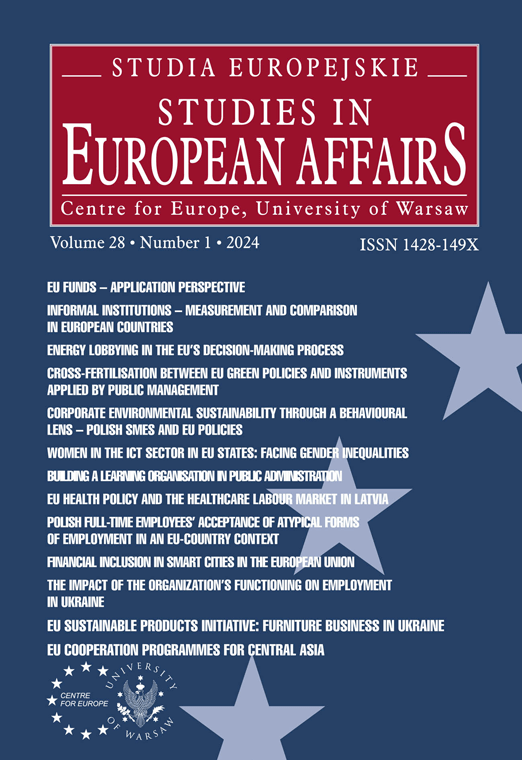
ISSUE: 1/2024
- Volume 28
- Number 1
- 2024
Subscribe NEWSLETTER
Studia Europejskie –
Studies in European Affairs
ISSN: 1428-149X
e-ISSN: 2719-3780
License
Articles published in the journal are under a Creative Commons Attribution – Non Commercial – No Derivatives 4.0 International License
European Union Funds – Application Perspective
Abstract
The result of an effective management of the redistribution of European Union funds should be a reduction of disparities between EU regions by guaranteeing their comprehensive and harmonious development and supporting the economic and social cohesion of member countries. A poorly-conducted programming process of financial interventionism, the source of which is EU funds, may result in divergence between regions, the direct effect of which would be their social and economic marginalisation. For this reason, it is important to skillfully manage those funds. The main aim of this article is to present the factors affecting the decision-making process of the use of EU co-financing, and that includes the pandemic as an external variable being a threat to the implementation of investments from the EU’s structural funds. To explain the multivariate associations between explanatory variables and the binary outcome variables, logistic regression was employed. Based on the tests’ results, significant associations were observed between the dependent variable and (a) participation in training co-financed by EU funds, (b) receiving information regarding additional EU funds as pandemic support, and (c) the suspension of planned investments using EU funds due to the pandemic situation. A comprehensive distribution of respondents according to the response categories in the analysed variables within the entire sample (N = 950) was presented. Corresponding associations were evident within a sub-sample (N = 303). The model showed that all significant independent variables explain the use of EU funds, but the model explains just 28.6% of the decision to use the funds. Thus, the following study indicates directions that require further research.
References
Brodecki, Z. (2005) Regiony. Warszawa: LexisNexis.
Camagni, R. (2017) Territorial Capital, Competitiveness and Regional Development in Huggins, R. and Thompson, P. (eds.) Handbook of Regions and Competitiveness: Contemporary Theories and Perspectives on Economic Development. Cheltenham: Edward Elgar Publishing. DOI: https://doi.org/10.4337/9781783475018.00016.
Dubel, P. (2012) Polityka regionalna i fundusze strukturalne w praktyce. Warszawa: Wydawnictwo Naukowe WZ UW.
Dubel, P. (2020) Zarządzanie funduszami strukturalnymi Unii Europejskiej a polityka rozwoju regionalnego – projekty i ich realizacja. Warszawa: PWE.
Dumciuviene, D., Stundziene, A. and Startiene, G. (2015) “Relationship Between Structural Funds and Economic Indicators of the European Union”, Inzinerine Ekonomika-Engineering Economics. Vol. 26(5), pp. 507–516. DOI: 10.5755/j01.ee.26.5.8831.
Giordano, B. and Dubois, A. (2019) “Combining Territory and Competitiveness in EU Regional Policy? Analyzing ERDF Investment Profiles in Regions with Specific Geographical Features”, Regional Studies. Vol. 53(8), pp. 1221–1230. DOI: https://doi.org/10.1080/00343404.2018.1495323.
Głąbicka, K. and Grewiński, M. (2005) Polityka spójności społeczno-gospodarczej Unii Europejskiej. Warszawa: Dom Wydawniczy Elipsa.
Hanushek, E.A. and Woessmann, L. (2020) “Education, knowledge capital, and economic growth”, The Economics of Education, pp. 171–182. DOI: 10.1016/B978-0-12-815391-8.00014-8.
Li, J., Yang, H., Weng, Q. and Zhu, L. (2023) “How different forms of job crafting relate to job satisfaction: The role of person-job fit and age”, Current Psychology. Vol. 42(13), pp. 11155–11169. DOI: 10.1007/s12144-021-02390-3.
Lövdén, M., Fratiglioni, L., Glymour, M.M., Lindenberger, U. and Tucker-Drob, E.M. (2020) “Education and Cognitive Functioning Across the Life Span”, Psychological Science in the Public Interest. Vol. 21(1), pp. 6–41. DOI: 10.1177/1529100620920576.
Martínez-Alcalá, C.I., Rosales-Lagarde, A., Pérez-Pérez, Y.M., Lopez-Noguerola, J.S., Bautista-Díaz, M.L. and Agis-Juarez, R.A. (2021) “The Effects of Covid-19 on the Digital Literacy of the Elderly: Norms for Digital Inclusion”, Frontiers in Education. Vol. 6. DOI: 10.3389/feduc.2021.716025.
Nowak, A.Z. (2005) Fundusze Strukturalne Unii Europejskiej jako czynnik mobilizacji gospodarki polskiej in Adamczyk, A. and Borkowski, J. (eds.) Regionalizm, polityka regionalna i Fundusze Strukturalne Unii Europejskiej. Warszawa: Centrum Europejskie UW.
Pihlainen, K., Ehlers, A., Rohner, R., Cerna, K., Kärnä, E., Hess, M., Hengl, L., Aavikko, L., Frewer-Graumann, S., Gallistl, V. and Müller, C. (2023) “Older adults’ reasons to participate in digital skills learning: An interdisciplinary, multiple case study from Austria, Finland, and Germany”, Studies in the Education of Adults. Vol. 55(1), pp. 101–119. DOI: 10.1080/02660830.2022.2133268.
Uryga, J., Magielski, W. and Bienias, I. (2007) Środki unijne. Gdańsk: ODDK sp. z o.o.
DOI: 10.33067/SE.1.2024.1
Language: English
Pages: 7-26
How to Cite:
Harvard
Dubel, P. and Majczyk, J. (2024) "European Union Funds – Application Perspective". Studia Europejskie – Studies in European Affairs, 1/2024, pp. 7-26. DOI: 10.33067/SE.1.2024.1